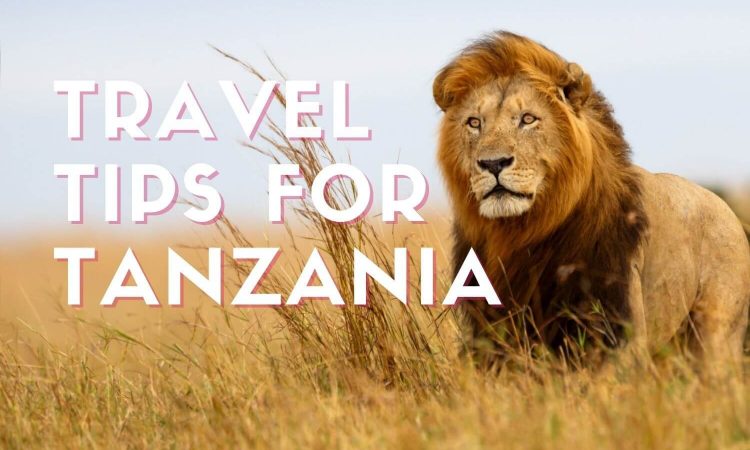
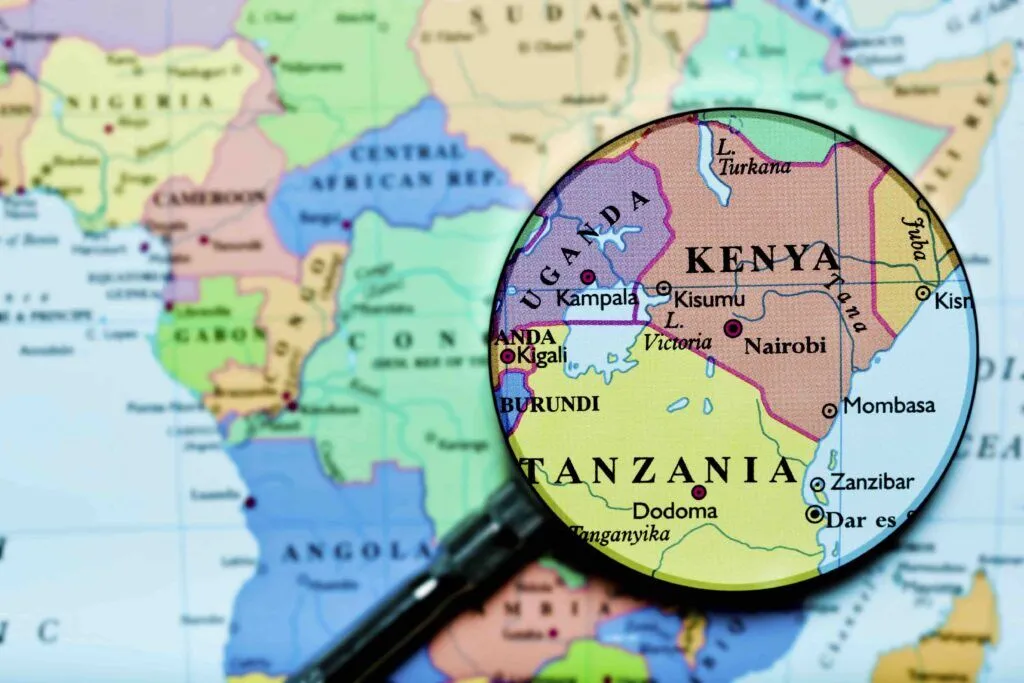
Whether you plan to explore Tanzania, immerse yourself in its rich culture, or experience its breathtaking natural beauty, we are here to help. In this guide you’ll find practical advice for a safe and memorable trip to Tanzania, including important information about yellow fever requirements, local weather, the ideal time to visit, our Flying Doctors Services for emergencies, and how to travel responsibly to catch up contribute to the preservation of this beautiful destination. Let us guide you on a journey full of adventure and discovery in Tanzania!
Do you have questions or want to get in touch with a member of the Tanzania Specialist team to discuss your upcoming trip? Contact us here.
The best time to visit Tanzania depends on what you want to see, where you want to go, your budget, and your interests. Every time of the year has its pros and cons. Here’s a guide to help you decide the best time for your Tanzanian adventure. Oh, and before we forget…Everyone is different, there is no correct choice. But one thing that’s for sure: A Tanzania Travel is beautiful the whole year!
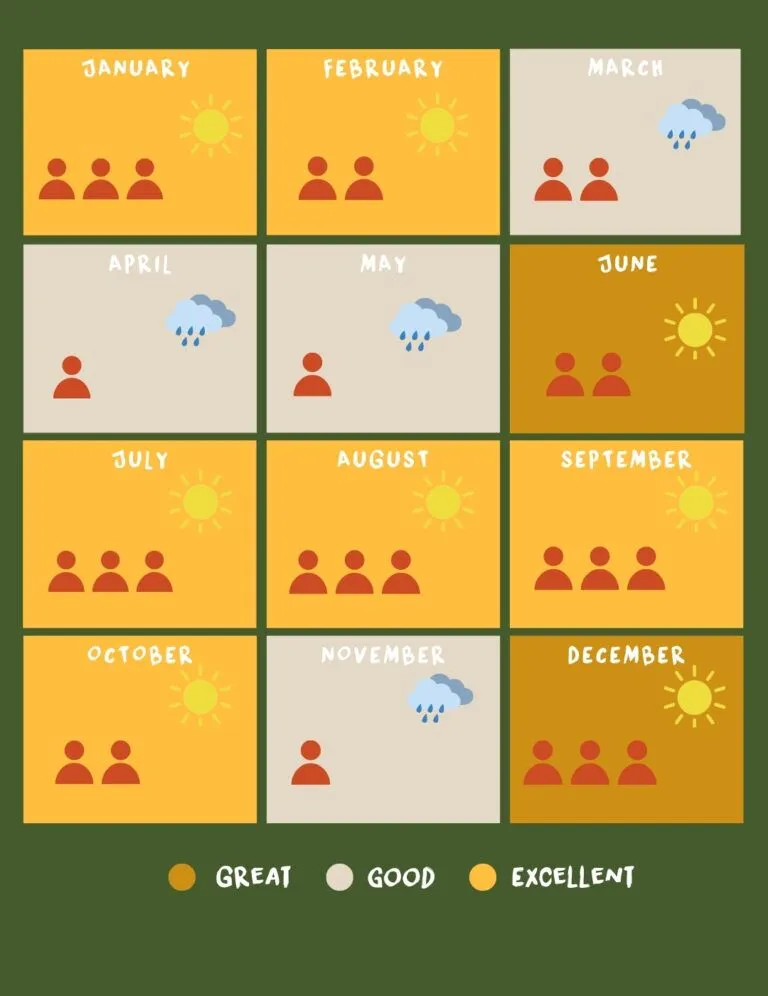
THE BEST MONTHS: JUNE TO OCTOBER & DECEMBER TO FEBRUARY
These months are the crème de la crème for visiting Tanzania! That’s why we rated them ‘Excellent’. Think of June to October as nature’s blockbuster season: sunny skies, wildlife galore, and the epic wildebeest migration. December to February is like hitting the safari jackpot, with lush green landscapes and adorable baby animals everywhere. And hey, March, April, May, and November are also cool to go—if you love vibrant greenery, bird-watching, and having the park almost to yourself, those months are a hidden gem. Yes, there might be rain, but still!
June to October (Dry Season)
This period offers the best wildlife viewing as animals gather around waterholes, with July and August being peak times for witnessing the dramatic wildebeest migration and river crossings; the weather is pleasant and sunny with fewer crowds.
December to February (Dry Season)
The dry season continues, providing excellent game viewing opportunities and pleasant weather; January and February are particularly special for witnessing the calving season in the southern Serengeti, attracting many predators…👀
March (Wet Season)
The rains begin, making the landscape vibrant and lush, with excellent bird watching and fewer tourists for a more intimate safari experience. And lower prices, of course!
April to May (Wet Season)
Heavy rains make some roads challenging, but the scenery is spectacular, and the parks are quiet with lower rates, offering a serene and affordable safari experience.
November (Wet Season)
Short rains start, rejuvenating the landscape with blooming flowers and green forests, while still offering good wildlife viewing in the northern parks. It is also generally less busy.
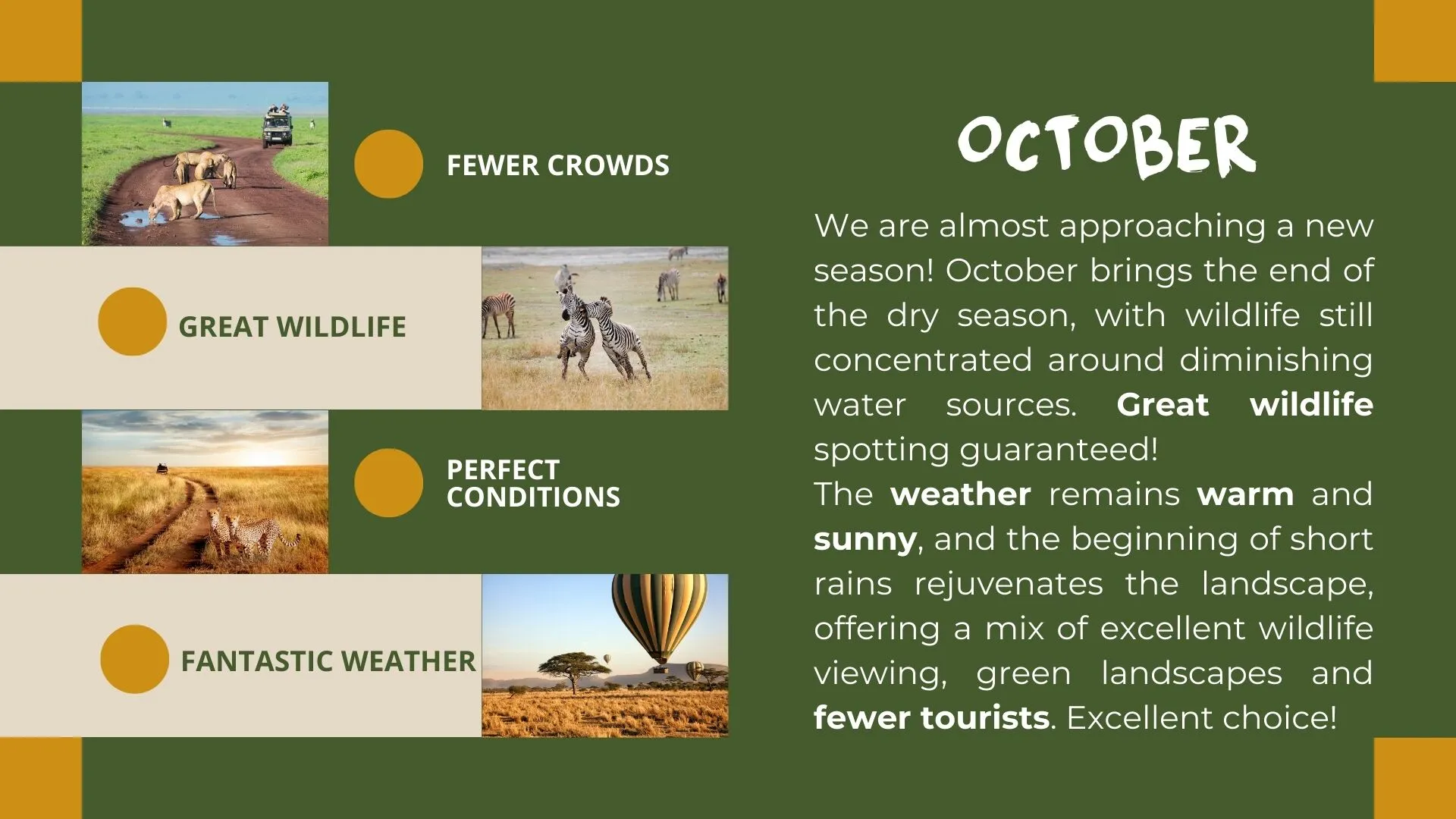
Best Time to Visit Tanzania: Month by Month Highlights. Highlights are based on climate, wildlife, safari experience, and feedback from our local guides.
DRY SEASON: PROBABLY THE BEST SEASON TO VISIT TANZANIA
The dry season is the most popular time for a safari in Tanzania. Why?
During this time, wildlife gathers around rivers and waterholes, making it easier to spot animals. The pleasant temperatures of 25-27 °C with sunny, rain-free days create ideal conditions for game drives and outdoor activities. You’ll be sitting in the game drive car with the sun shining while wildlife makes their way to the waterholes for a much-needed refreshment.
Fewer mosquitoes and better road conditions enhance your safari experience. The dry season also offers the best opportunities to witness the wildebeest migration, especially the dramatic river crossings in the northern Serengeti. For those looking to climb Kilimanjaro, the clear blue skies and cooler temperatures from evening to early morning make for perfect climbing conditions.
When is the dry season?
- January
- February
- June
- July
- August
- September
- October
- late December
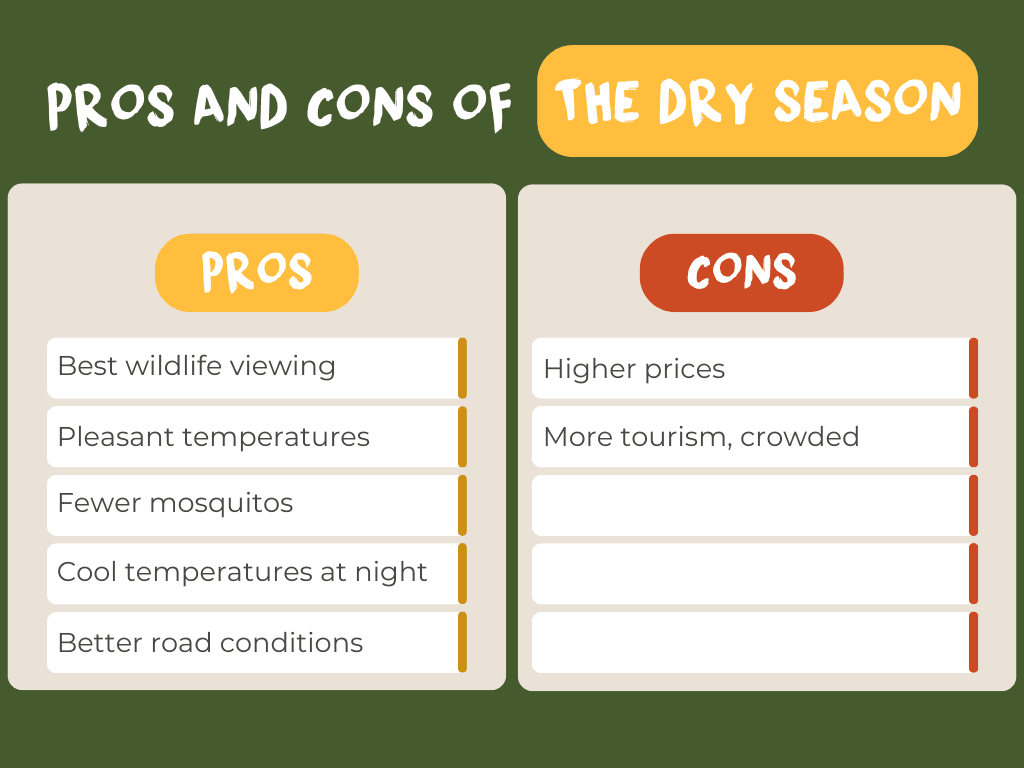
Pros of traveling during the dry season
- Wildlife gathers around rivers and waterholes, making it easier to spot
- Pleasant temperatures of 25-27 °C with sunny and rain-free days
- July and August are great for witnessing the wildebeest migration and epic river crossings
- Fewer mosquitoes
- Better road conditions and easier game drives
- Best time to visit the southern parks; northern parks are accessible all year round
- Cool temperatures from evening to early morning
- Clear blue skies
- Best conditions for climbing Kilimanjaro
However, there are some cons to consider:
Cons of traveling during the dry season
- Higher prices for accommodations and tours
- Unique accommodation tends to sell quick!
- More tourists during this popular time, leading to busier parks and lodges
Want to avoid busier parks and higher prices? Keep reading!

WET SEASON: FOR AN INTIMATE SAFARI EXPERIENCE
The wet season, also known as the rainy season, offers a different but equally captivating experience. Why? Nature is vibrant and lush with blooming flowers and green landscapes. Bird watching is at its best, and the parks are less busy, providing a more intimate safari experience. Plus, lower rates make it a more affordable time to visit.
When is the wet season?
- March
- April
- May
- November
- Beginning December
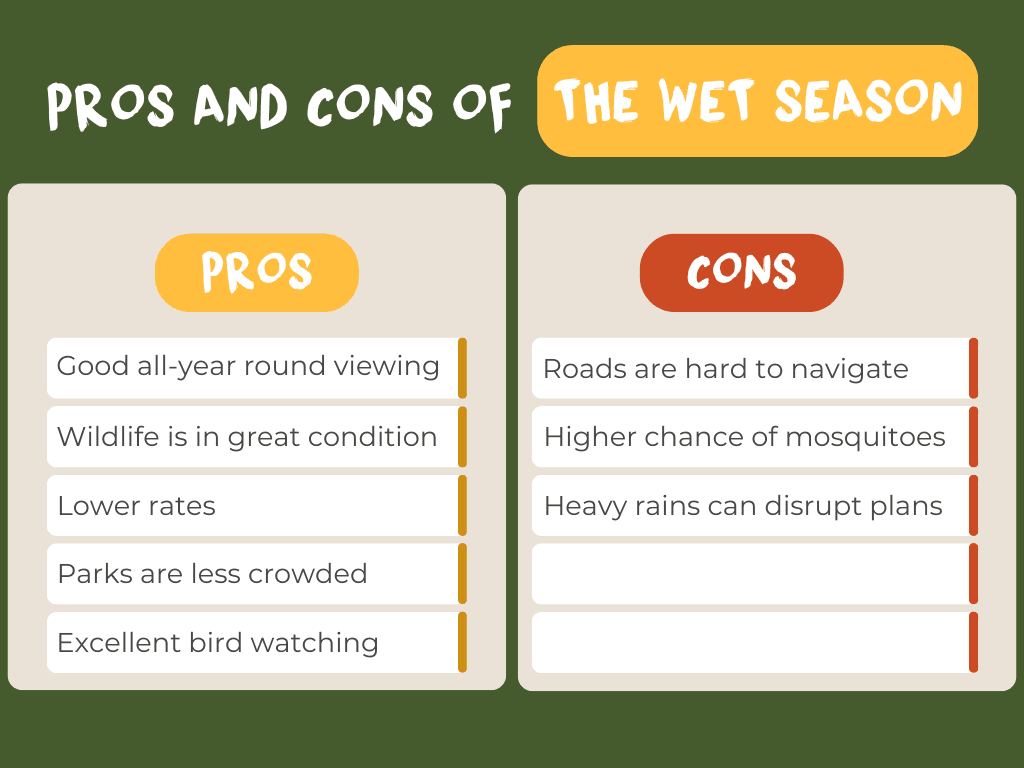
Pros of traveling during the wet season
- Nature is vibrant and colorful with blooming flowers and green forests and grasslands
- Good all-year wildlife viewing in northern Tanzanian parks
- Excellent bird watching
- Wildlife is in good condition
- Lower rates make it a cheaper safari option
- Parks are less busy, providing a more intimate safari experience
However, there are a few downsides to keep in mind:
Cons of traveling during the wet season
- Some roads may be difficult to navigate due to rain
- Higher chance of encountering mosquitoes
- Afternoon showers can disrupt plans
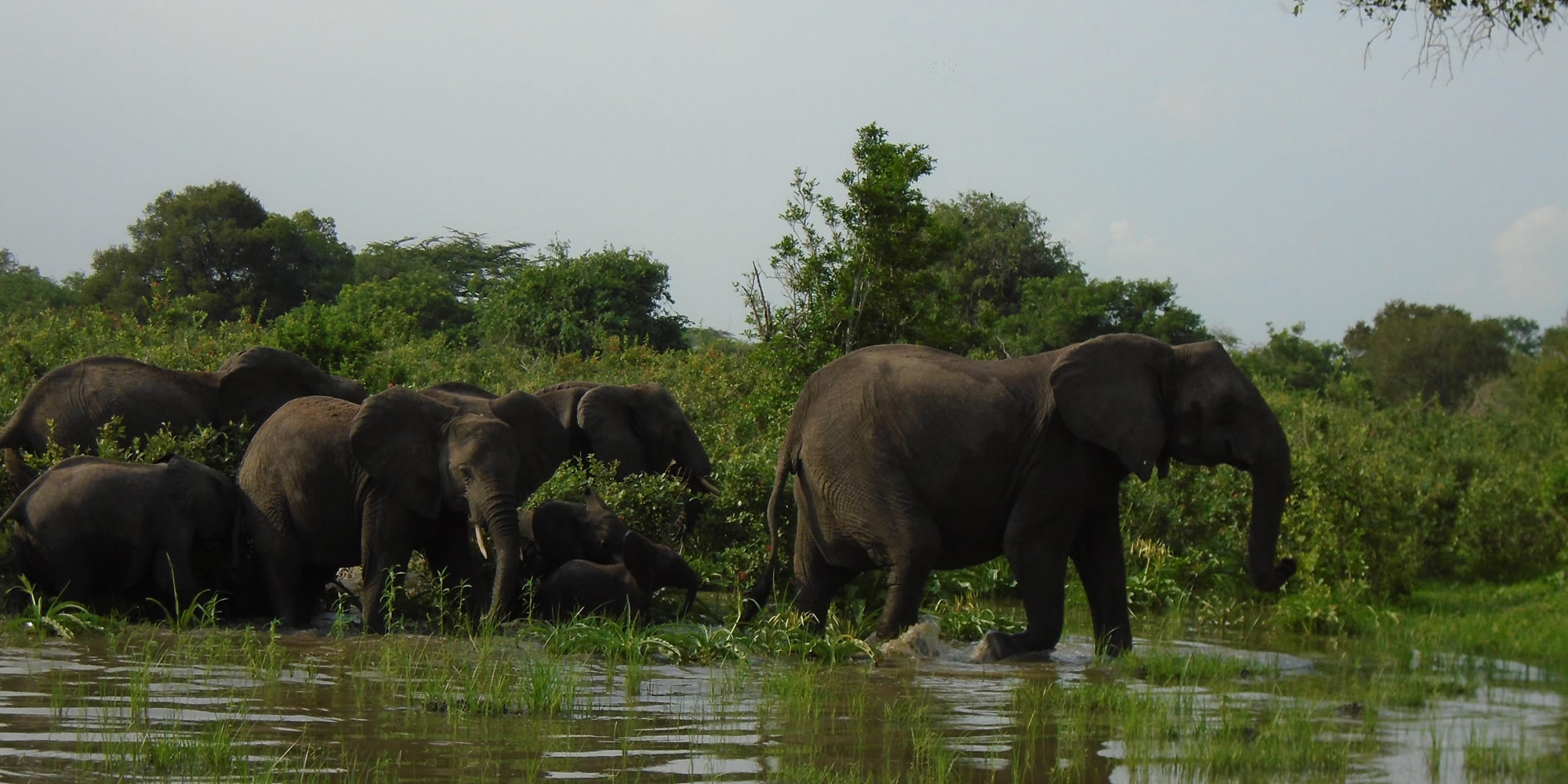
Anything else to look out for, except dry and wet season? Tanzania’s tourism can be divided into three distinct seasons: high, mid, and low. These go hand-in-hand with Tanzania’s wet and dry season. Each season has its own unique advantages and challenges, helping you decide the best time to plan your visit based on your preferences and priorities.
LOW, MID, AND HIGH SEASON IN TANZANIA
High Season: January, February, June to October, and December.
Visiting Tanzania during the high season guarantees ideal weather conditions and the best wildlife viewing opportunities. With sunny skies, pleasant temperatures, and the incredible wildebeest migration, it’s the perfect time for a memorable safari adventure.
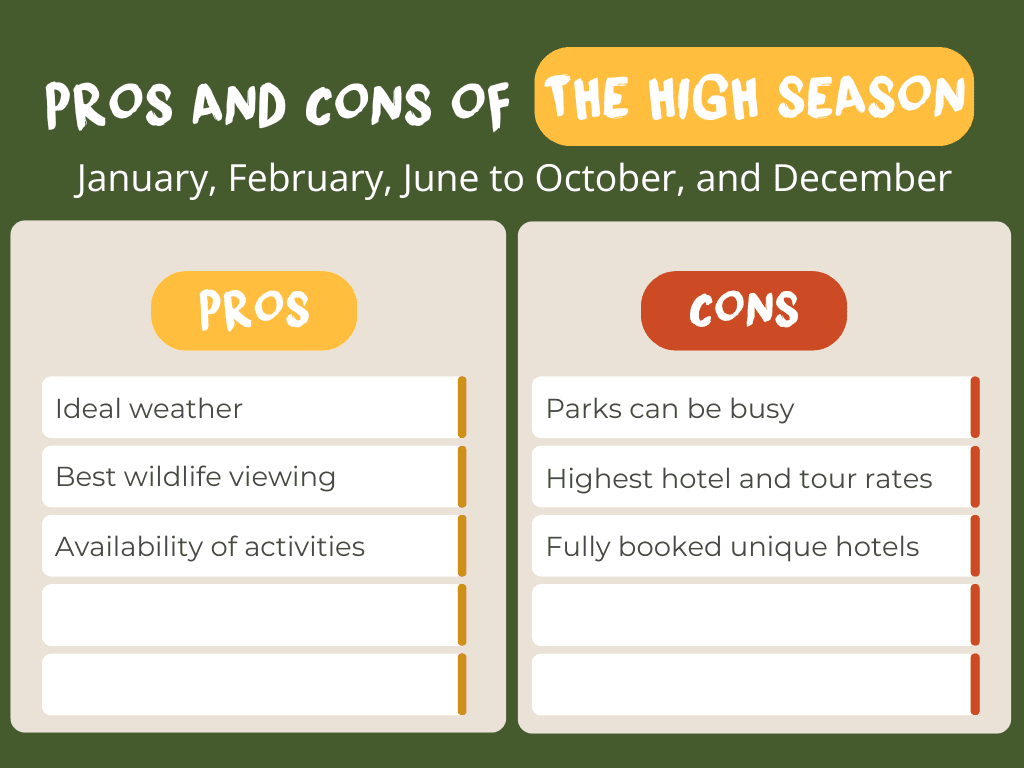
Pros:
- Ideal weather conditions for safaris and beach visits
- Best wildlife viewing opportunities
Cons:
- Parks and attractions can be busy
- Highest hotel and tour rates
- Unique hotels are fully booked
- Availability of most tourist services and activities
Mid Season: March, November 1st to December 21st.
The mid-season offers a balance between the high and low seasons, making it a great option for travelers seeking moderate prices and fewer crowds without compromising too much on weather and wildlife sightings.
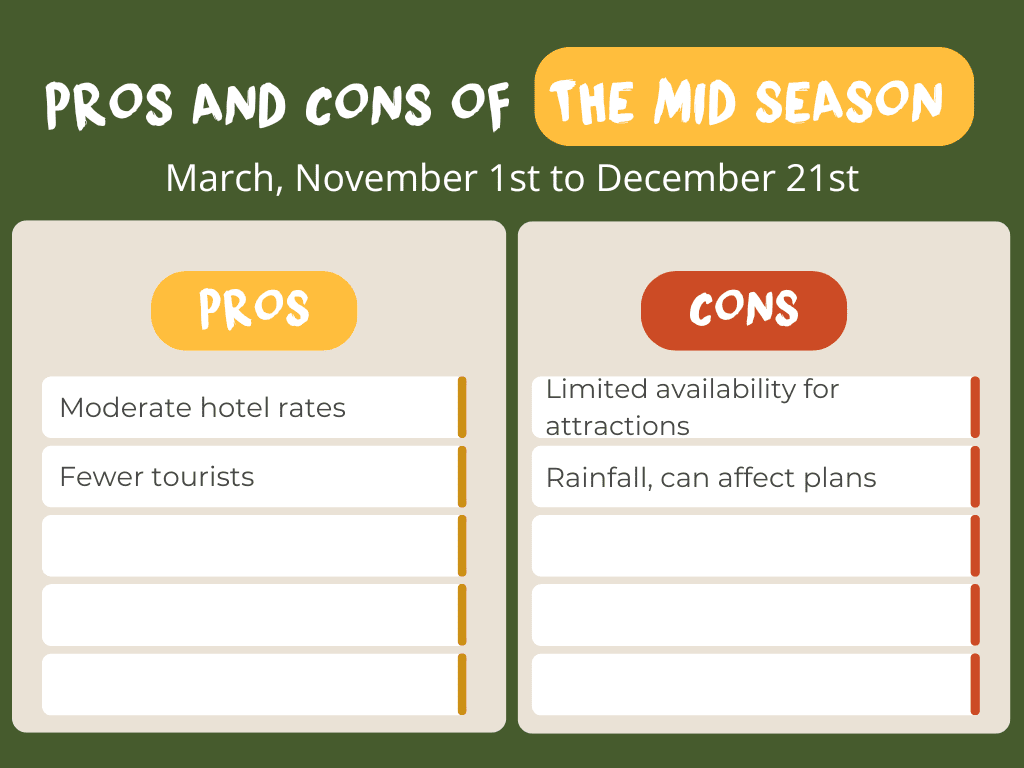
Pros:
- Moderate hotel rates
- Fewer tourists compared to the high season
Cons:
- Some attractions may have limited availability
- Variable weather conditions
Low Season: April and May
The low season is perfect for budget-conscious travelers who don’t mind a bit of rain and are looking for a more peaceful and serene experience in Tanzania’s stunning landscapes.

Pros:
- Lowest hotel and tour rates
- Least busy parks and attractions
Cons:
- Some lodges and camps may be closed
- Highest rainfall, which can affect travel plans
Every season in Tanzania offers a unique and beautiful experience, ensuring a memorable trip no matter when you visit!
EXPERIENCE THE GREAT MIGRATION YEAR-ROUND IN TANZANIA
Great news: You can witness the awe-inspiring Great Migration all year long as it moves between the Maasai Mara in Kenya and the Serengeti in Tanzania. No matter when you travel, you won’t miss this incredible event. Let us break down when and where you can see the highlights, so you can choose what’s most important to you!
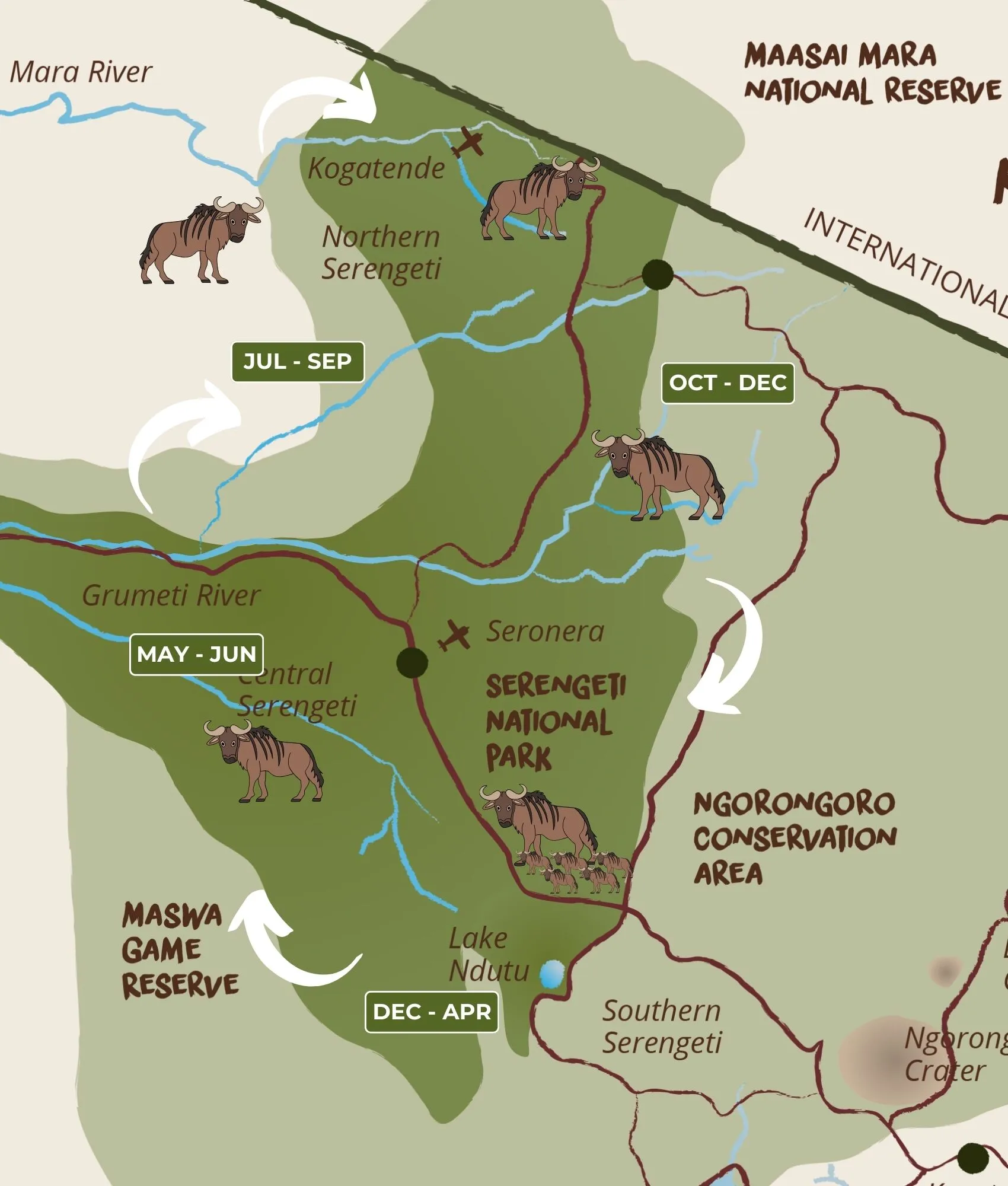
December – March
Witness the breathtaking Great Migration in the southern Serengeti, with the magical sight of newborn animals in February.
July – September
Experience the thrilling river crossings in the northern Serengeti, a spectacular highlight of the Great Migration.
For more details on where the wildebeest migration is throughout the year, check out our article on the Great Wildebeest Migration.
WHEN IS THE BEST TIME TO VISIT TANZANIA, BASED ON THE WEATHER.
For more detailed information on the weather, check out our page about the weather in Tanzania.
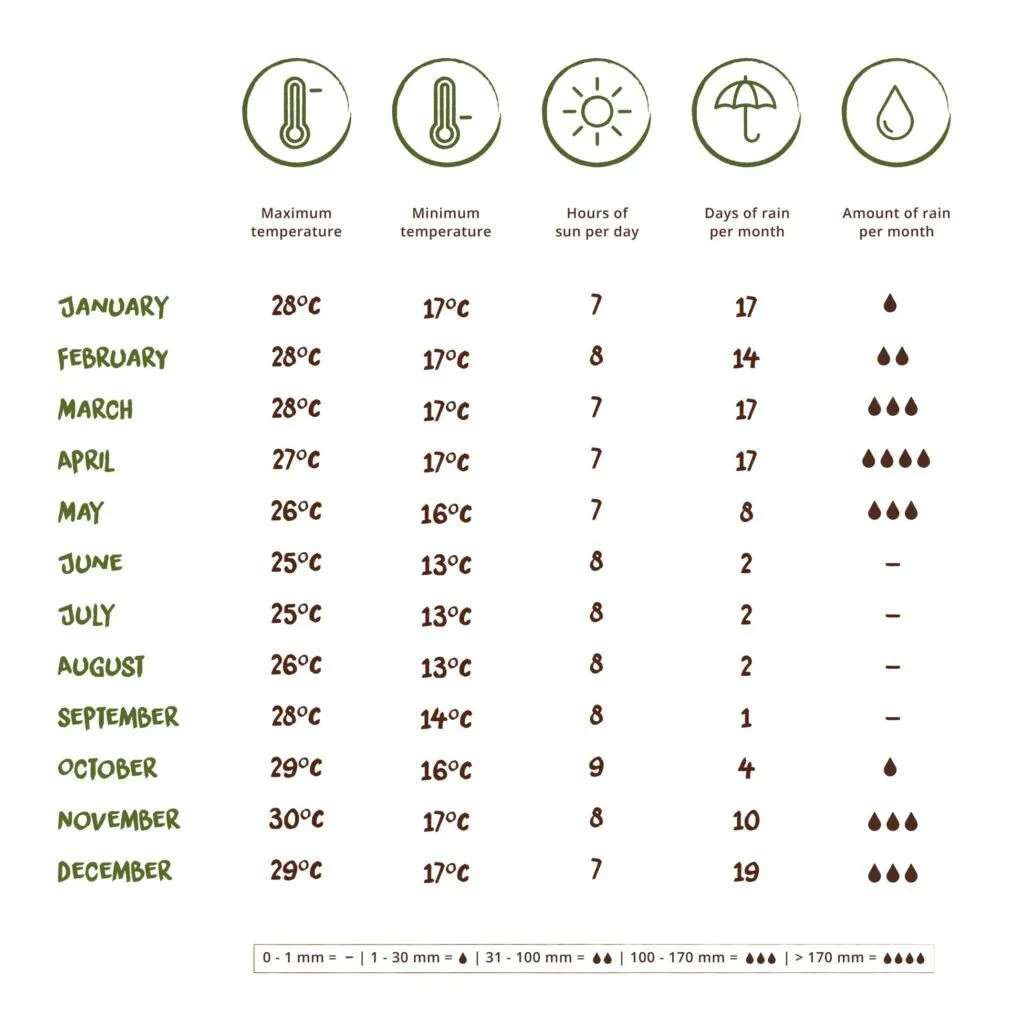
Tanzania weather differs from region to region – but there is always a great time to travel in Tanzania! Weather in the coastal areas is the hottest and most humid, while the North and highlands of Tanzania are cooler because of altitude. The temperatures vary between 22°C and 31 °C throughout the year. During the night, the temperature in Tanzania drops to between 10°C and 22°C. The beaches of Zanzibar have a distinctively tropical climate since it is located close to the Equator.
TANZANIA WEATHER: THE SEASONS
Tanzania has two seasons yearly: the wet and the dry season. The wet season (also called the rainy season) runs from the end of October right through to December, and then again from the end of March to the beginning of June. They are referred to as the ‘short-’ and ‘long rains’. These tropical rains mostly start late afternoon and continue all night till early morning. The rains of Africa are famous worldwide and are a soothing, enchanting sight to behold during a trip to Tanzania!
CAN I GO ON SAFARI DURING THE RAINY SEASON?
Did you know that National Geographic, Discovery and other major media companies choose the rainy season to shoot their wildlife documentaries in Tanzania? Tanzania weather is fantastic all year round and though heavy rains persist most afternoons in the rainy season, the natural environment comes to life. Nature is colourful, the grass is lush and green, beautiful flowers grow, animals find plenty of food, temperatures are nice and cool and, better yet, the main highlights of Tanzania are far less crowded with tourists.
Another benefit of travelling in rainy reason is the lower costs of safaris and accommodation during this low season. The disadvantages of travel during the wet season are that some accommodations are closed and the (sometimes) poor road conditions. Fortunately, this mainly concerns the roads in the national parks in South Tanzania.
For those travelling to Tanzania during the rainy season, the following national parks are open and ready for your visit. Serengeti, Ngorongoro Crater, Tarangire, Lake Manyara, Lake Natron and Arusha National Park. The national parks of Tanzania that are better avoided during the wet season include Nyerere, Ruaha, Mikumi & Udzungwa. So if any of the latter destinations are on your must-do list in Tanzania, be sure to head out in dry season.

HOW DOES TANZANIA WEATHER AFFECT WILDLIFE?
The rain makes for a lush landscape with a high concentration of animals. This means plenty of opportunities to spot wildlife at their finest – and happiest! During the rainy seasons, animals are more active which makes for a fantastic safari experience. With an abundance of food and fresh water, animals roam in their thousands. The rain also protects the animals from the harsh heat of the sun.
Many of our safari guests say that the rainy season offers a more intimate safari experience. For bird lovers, the rainy season is a fantastic time of year to visit Tanzania as lots of migratory birds arrive.
For more detailed information on Tanzania weather and when you should travel to Tanzania, check out our page on the best time to visit Tanzania.
With almost a decade of experience, we’re proud to be able to offer customised Tanzania travel advice that is second-to-none. Here we answer your top questions regarding need-to-know Tanzania travel advice.
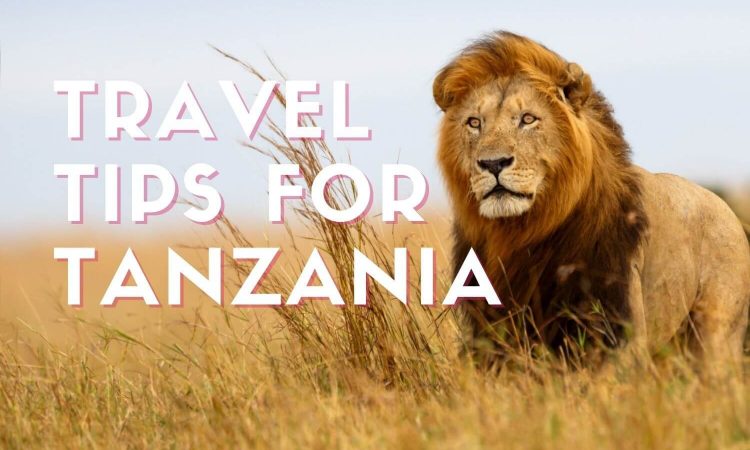
IS TANZANIA SAFE TO TRAVEL?
”I want to visit Tanzania, but is it safe?” This is a question that regularly comes up from our clients seeking Tanzania travel advice. The short answer? Yes! Tanzania is one of the safest destinations in Africa, with more than 1 million tourists visiting the country every year.Travelling with the travel experts at Tanzania Specialist, safety is paramount. Our private safari experiences with knowledgeable, professional guides enhance your experience in Tanzania and ensure your total peace of mind.Check out our Tanzania safety tips for more information on safe travel in Tanzania.
WHAT IS THE POPULATION OF TANZANIA?
The population of Tanzania is almost 60 million. One of Africa’s most ethnically diverse countries, around 125 different ethnic groups live in Tanzania, with more than 100 different languages spoken nationwide.
The Tanzanian people are well-known for their hospitality, often warmly welcoming tourists to experience their beautiful nature, wildlife and culture. Meeting the locals is one of the best ways to really learn more about a country and its culture and is well recommended on your Tanzania discovery!
DO I NEED A VISA FOR TANZANIA?
Most international travellers will need a visa to travel to Tanzania. Your visa can be requested online through the official visa website from the Tanzanian government. Please note that this is the only official link for Tanzania visa applications.
It is also possible to get a tourist or business visa for a single entry on arrival at the main ports of entry to Tanzania. This visa for Tanzania is valid for three months. You may be asked to provide proof of your return journey, and costs are $50 per person, US Citizens $100 per person.
When arranging your trip to Tanzania with Tanzania specialist, we guide you through every step of the visa and administration process.
PASSPORT REQUIREMENTS
Passports should have at least six months of validity after the final day of travel.
SAFETY FIRST: DON’T FORGET YOUR TRAVEL INSURANCE
When it comes to embarking on your dream adventure to Tanzania, your safety is our top priority! That’s why we urge all travelers to ensure they have comprehensive travel insurance in place before setting off. While Africa Safari Trips doesn’t provide travel insurance directly, we’re delighted to recommend Chapka Travel Insurance as your go-to provider for your upcoming trip to Tanzania.
With Chapka, you can rest assured that you’re fully covered for every aspect of your journey, from unexpected medical expenses to trip cancellations. Their personalized service means you only pay for what you truly need, giving you peace of mind to immerse yourself in the wonders of Tanzania. So, before you pack your bags and set off on your safari, remember: Safety First. Don’t forget your Travel Insurance with Chapka.
WHAT VACCINATIONS ARE NEEDED FOR TANZANIA?
A yellow fever vaccination certificate is only required for travellers one year of age and older coming from – or who are in airport transit for more than 12 hours within – a country with risk of yellow fever transmission.
In addition to standard vaccinations such as MMR and TDP, the CDC and WHO recommend vaccinations for Tanzania, such as Hepatitis A, hepatitis B, and typhoid. Yellow fever and rabies vaccinations are also recommended depending on the traveller’s activities. As of January 2023 there are no more COVID-19 restrictions in Tanzania, and vaccinations or PCR-tests are no longer necessary before traveling.
As with all international travel, we always advise you to consult your physician for professional health advice before travelling to Tanzania.
WHAT IS THE TIME IN TANZANIA?
Tanzania is GMT + 3. To put that into terms we all understand, check out the time difference from Tanzania to LA, New York, London and more below.
Los Angeles: -10 hours
New York: -7 hours
London: -3 hours
Berlin: -2 hours
Hong Kong: +5 hours
Tokyo: +6 hours
Sydney: + 8 hours
Auckland: +10 hours
WHAT IS THE CURRENCY OF TANZANIA?
The local currency is the Tanzanian shilling, although dollars and euros are also accepted in most places in Tanzania.
LANGUAGE IN TANZANIA
There are over 100 different languages spoken in Tanzania. The official languages, however, are Swahili and English. You can expect all your Tanzania Specialist guides and hosts to speak English, but if you’re looking to learn a few words of Swahili before your trip, check out our list of top 25 useful words in Swahili!
Swahili and English are the official languages in Tanzania, but Swahili is spoken by almost everyone. In the tourism sector, however, English is widely spoken by the majority of people.
Travelling in Tanzania is more than just a vacation. For many explorers of Tanzania, this is a bucket-list adventure to remember for a lifetime. For detailed Tanzania travel advice or to start planning your custom vacation in Tanzania, contact us now.
We look forward to welcoming you to Tanzania soon!
Tanzania yellow fever requirements can sometimes seem confusing, but we’re here to help! As a yellow fever-free country, Tanzania is safe to travel when it comes to steering clear of this virus. On this page, we answer all your questions on the yellow fever virus and whether a yellow fever vaccine is required for Tanzania.

DO I NEED A YELLOW FEVER VACCINATION FOR TANZANIA?
Great news: for the vast majority of travellers to this beautiful country, you do not need this vaccine! According to the World Health Organization’s classification, Tanzania currently poses a low risk of yellow fever. If you reside in a country with no risk of yellow fever, then you do not need the yellow fever vaccine as part of your necessary travel vaccinations.
WHAT IS YELLOW FEVER?
Yellow fever is a viral disease spread through mosquito bites. Symptoms of yellow fever typically take 3 to 6 days to develop and can include fever, chills, headache and muscle aches. Yellow Fever is serious, with around 15% of people who get yellow fever develop a serious or life-threatening illness.
As Tanzania is safe from yellow fever, if you are directly travelling from Europe or the United States, there are no yellow fever vaccine requirements.

TANZANIA YELLOW FEVER REQUIREMENTS
Proof of yellow fever vaccination is only required upon arrival if you are travelling from a country with a risk of the virus. This list currently does not include any country in Europe and the United States. (View the full list of Yellow Fever high-risk countries).
An important note, however. If you’re transiting through one of the yellow fever high-risk countries for a period of 12 hours or more, you will be required to receive the yellow fever vaccination. If this is the case on your trip to Tanzania, we strongly advise seeing your doctor and checking your Tanzania vaccination requirements with a healthcare professional before travelling.
RECEIVING THE YELLOW FEVER VACCINATION
The yellow fever vaccination is given as a single dose and should be administered at least 10 days before entering a high-risk yellow fever country. A single dose is capable of providing life protection against the yellow fever virus so make sure you receive proof of vaccination from your doctor or health professional. If you are required to receive a yellow fever vaccine before travelling, you will also need to show your proof of vaccination upon arrival in Tanzania.
Should your doctor recommend against the vaccine due to underlying health issues or other health-related factors, you can still travel to Tanzania with an official letter from the doctor. Showing it to the immigration officer upon arrival would waive the requirement, and your trip will go on as planned.
For more information on requirements for yellow fever vaccinations when travelling in Tanzania, get in touch with the team at Marimbo Expeditions.
HOW TO GET YOUR VISA FOR TANZANIA
After you’ve booked one of our Tanzania safaris or Zanzibar holidays (hooray!), the next thing is to apply for your tourist visa. For many, this leads to worries and insecurities. How to apply? Where to apply? What documents do I need? Luckily for you, getting a visa for Tanzania is relatively easy, especially when booking with us. Read on to know more.
When travelling to Tanzania, you can either get your visa online or upon arrival*. Both ways are fine and valid, even though the Tanzanian government prefers you use the online option as they are keen to show Tanzania is a modern country. Below, we broke down more pros and cons of both ways of applying. But first, let’s talk about the costs.
TANZANIA VISA: HOW MUCH DOES IT COST?
The costs for a Tanzania visa differ slightly per nationality. Are you coming from Europe? Then the fee is 50 USD. Are you a US citizen? Then you need a multi-entry visa for the price of 100 USD. Both are valid for three months, but the multi-entry visa allows you to leave the country and come back again with the same visa within one year.
The amounts above apply when you purchase your visa online. If you apply upon arrival the costs are either 50 USD or 50 EUR (or 100 USD for the multi-entry visa). A bit surprising because of course 50 EUR is worth more than 50 USD. In any case, you can also pay with a credit card, and then the fee is 50 or 100 USD plus credit card fees. The choice is yours.
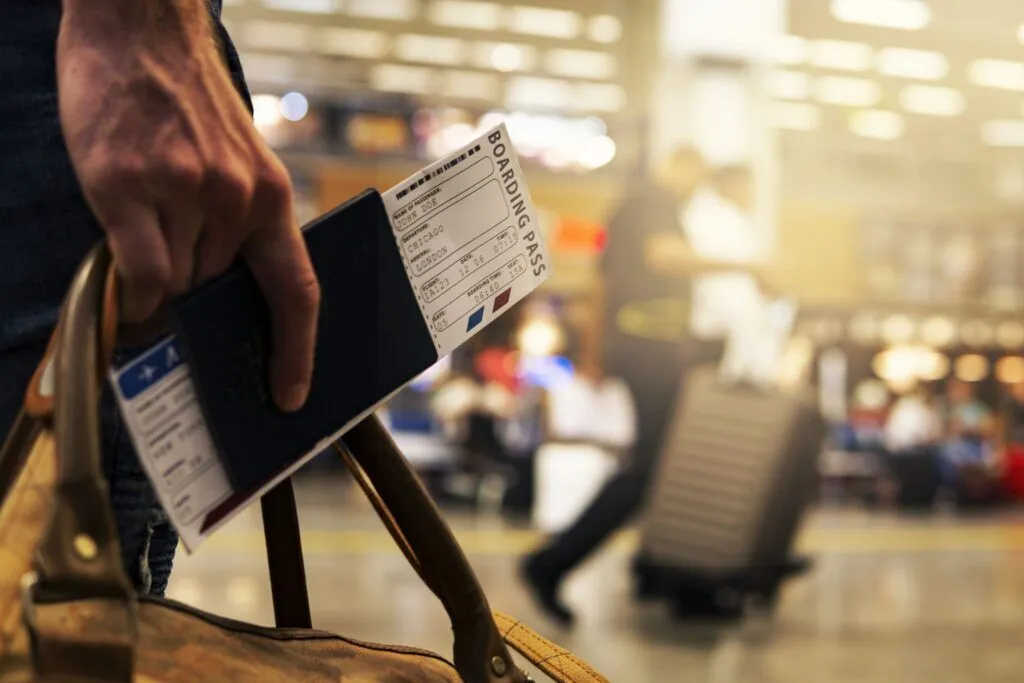
ONLINE APPLICATION
The Tanzanian government prefers it when you apply online, and truth be told, it does have its perks:
- The process is relatively easy, especially with the explanatory PDF you get when booking through us.
- You board your plane knowing your visa is arranged and paid for.
- Upon arrival, you only have to wait at one counter to get your visa stamped.
To apply for a visa online, you go to the official portal of the Tanzanian government. We advise you to NOT apply through any other website because they are either more expensive or scams. We know of several travellers who lost their money through these scams, so it’s better to be safe than sorry. The official portal is:
https://eservices.immigration.go.tz/visa/
People booking with us get a special PDF to guide them through the process. And our travel consultants are always available for advice. We cannot apply for your visa for you, but this way it can hardly go wrong. After submitting your application it can take up to ten days before your visa is processed and approved. Make sure to take a print or download with you when you go. Upon arrival, you only have to queue at the immigration counter to get your visa stamped in your passport. Then you collect your bags and you’re good to go.
APPLY FOR A VISA UPON ARRIVAL IN TANZANIA
If, for some reason, you cannot or don’t want to apply online, as of March 2024, you can also still apply upon arrival*. Brace yourself to experience some nice African bureaucracy, but other than that, the process is quite easy:
- You fill out an application form upon arrival at the airport (keep a pen at hand and have the address of Tanzania Specialist and your first lodge at the ready).
- Apply at the visa counter.
- Go to a second counter to pay your visa fee, and pay either in cash or by credit card.
- Go to a third counter, and get the visa stamped in your passport.
- Get your bags and you’re good to go.
As you can see, when applying upon arrival you have to queue three times, whereas if you apply online you only queue once upon arrival. So applying the old-fashioned way might slow you down a bit, but hey; you are in the country of ‘pole pole’ now – no hurry in Africa! You might as well get used to it. And just between you and us: these days so many people apply online that the one queue for online applications is way longer than the three queues you take when applying upon arrival. So you might even be out quicker.
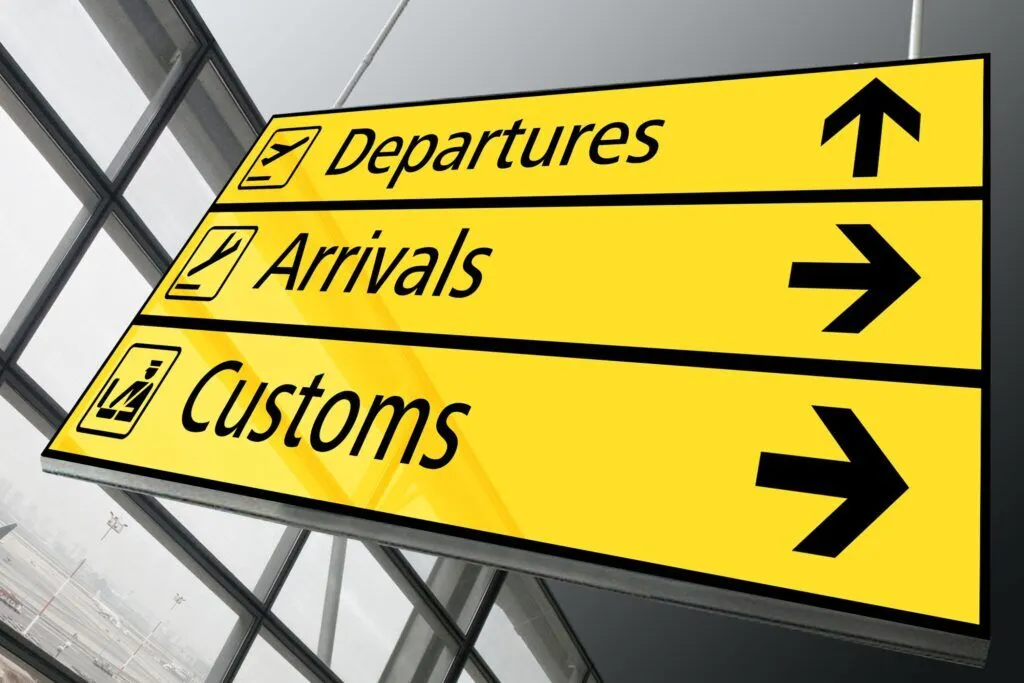
THE CHOICE IS YOURS
Nowadays, most people prefer to apply online, just to be sure to have that visa in their pocket before travelling. Which is understandable. If you decide to apply online, make sure to be prepared:
- Apply three to four weeks before travelling, in case your application gets denied. This will give you enough time to correct the mistakes and apply again.
- Have a credit card ready for your payment, or know how to make an international bank transfer.
- Have a digital passport-size picture, a picture of your passport’s biodata page (max 300 kB) and a PDF of your flight ticket (max 1 MB) ready.
- Make sure your passport is valid for six months upon return from Tanzania.
- If children travel with only one parent, you need a written document in English with the consent of the other parent for the trip and then you have to upload this into the system.
- Make sure to have a pen at hand when arriving in Tanzania, because sometimes there is still a form they ask you to fill.
If you decide to be a bit adventurous and apply upon arrival, don’t board the plane unprepared either.
- Carry the amount needed for the fee in cash (USD/EUR), or use your credit card.
- No passport-size picture is needed.
- Have a pen at hand to fill in the application form, and the addresses of Tanzania Specialist and the first hotel you stay in.
- If children travel with only one parent, you need a written document in English with the consent of the other parent for the trip.
It’s up to you how you apply for your visa – whatever gives you the least stress. As long as you keep the end goal in mind: to get that visa. Because only with your visa in hand, you can get your bags and start your safari adventure with us.
Nationals of some countries need a so-called Referral Visa and are not allowed to apply upon arrival. So make sure to check that before you decide how to apply. Also, applying upon arrival might not be possible anymore in the future for anyone, so make sure to check the immigration guidelines before you leave to confirm that it’s still possible.
FLYING DOCTORS SERVICES
While planning your safari in East Africa, you might worry about having a medical emergency in the middle of nowhere. Luckily, the AMREF Flying Doctors are here to save the day, as they offer a flying ambulance service with doctors and pilots on standby 24 hours a day in the whole of East Africa. For 40 USD per person for 30 days, you can travel worry-free to any remote area in one or more of the following countries: Tanzania, Kenya, Uganda, Burundi and Rwanda.
Stepped on a snake?
In a medical emergency, Flying Doctors can give professional advice or immediately evacuate you to a hospital in Nairobi, Kenya. If, for example, through some bad luck you step on a snake in Kenya’s Masai Mara, you are just a phone call away from professional advice that might allow you to continue your journey.
And if, by some freak accident, you badly break your leg while getting on a boat in Uganda’s Queen Elizabeth National Park, or a pre-existing medical condition suddenly causes trouble in the middle of Tanzania’s Serengeti National Park (knock on wood!), in no time a flight with a whole team of medical professionals can be waiting for you at the nearest airstrip. The team then takes you straight to the hospital in Nairobi, where further help will be available.
Mind you, Flying Doctors always assesses what help is needed and only covers the emergency assistance and transport. Costs for a visa (when coming from outside of Kenya and being flown to Nairobi), and costs for the hospital and your treatment are on you. It doesn’t replace the need for health and/ or travel insurance. AMREF Flying Doctors can help smoothen the process for the visa, however, making sure you reach the hospital in time.
Peace of mind
Your safety is our priority, which is why we gladly help you subscribe to the Flying Doctors Insurance. During the safari, we do our utmost best to make sure everything goes well and 99 per cent of the time, our clients come back having had the best time of their life.
But it’s always good to realize you are travelling to a place of untamed nature, where wild animals rule and unexpected things happen. Flying Doctors have been flying since 1957 for that reason, allowing safari lovers to travel with complete peace of mind. Because we all like a bit of adventure – but not too much!

TRAVEL INSURANCE TANZANIA
We require our clients to have proper travel insurance. Travel insurance covers not only medical expenses, but also damage to or loss of luggage, among other things.
CANCELLATION INSURANCE TANZANIA
It is advisable to sign up for a cancellation insurance. In some cases, only a certain amount is refunded in case of cancellation for long trips. Please check this with your insurer to make sure you are properly insured.
Content Coming Soon…..


